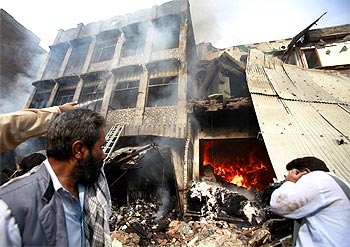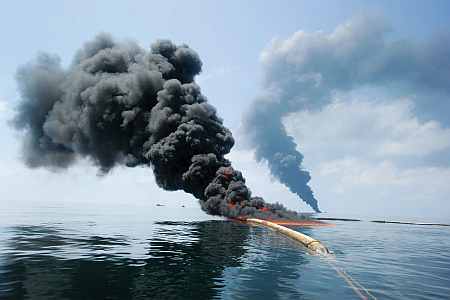 | « Back to article | Print this article |
'Victims of terror attacks remain overwhelmingly Muslim'
Afghanistan, Pakistan and Iraq account for the majority of terrorist attacks world-wide even as terror strikes in 2011 dropped as compared to 2010, a United States report has said, noting that victims of these attacks overwhelmingly are Muslims.
"The total number of worldwide attacks in 2011 was more than 10,000 in 70 countries, resulting in more than 12,500 deaths. But that figure, large as it may be, is a drop of 12 per cent from 2010," the Ambassador at Large and Coordinator for Counter-terrorism, Daniel Benjamin, told reporters at a news conference.
"Again, the largest number of reported attacks occurred in South Asia and the Near East. More than 75 per cent of the world's attacks and deaths occurred in these regions. The victims of terrorist attacks remain overwhelmingly Muslim," he said.
Click NEXT to read further...
'Most terror strikes in Pakistan, Afghanistan, Iraq'
"The majority of attacks occurred in just three countries - Afghanistan, Iraq, and Pakistan, which together accounted for 85 per cent of attacks in these regions and almost 64 per cent of attacks worldwide," he said.
"Although it's worth noting that both Afghanistan and Iraq saw declines in the number of attacks from the previous year - 14 per cent in the case of Afghanistan, 16 per cent in the case of Iraq," the top American counter-terrorism official said on the occasion of release of 'Country Report on Terrorism 2011'.
Africa, he said, experienced 978 attacks in 2011, an 11.5 per cent increase over the previous year.
"This is attributable in large part to the more aggressive attack tempo of the Nigerian-based terrorist group Boko Haram, which conducted 136 attacks in 2011, up from 31 the previous year," he said.
According to the National Counter-terrorism Center (NCTC), the Near East and South Asia suffered 7,721 attacks and 9,236 deaths.
The majority of those occurred in just three countries -- Afghanistan, Iraq and Pakistan -- which, together, accounted for 85 per cent of attacks in these regions and almost 64 percent of attacks worldwide.
"While attacks in Afghanistan and Iraq decreased from 2010 by 14 and 16 per cent, respectively, attacks in Pakistan increased by eight percent," he said.
Attacks in Europe and Eurasia fell 20 per cent from 703 in 2010 to 561 in 2011.
Click NEXT to read further...
'Terror strikes in 2011 down as compared to 2010'
The greatest decline occurred in Russia where terrorist attacks were down from 396 in 2010 to 238 in 2011.
In contrast, Turkey experienced a spike in terrorist attacks, rising from 40 in 2010 to 91 in 2011.
Together, Russia and Turkey suffered almost 70 per cent of all 2011 terrorism-related deaths in Europe and Eurasia, the report said.
The number of terrorist attacks in East Asia and the Pacific declined for the fifth consecutive year, falling 25 per cent from 724 in 2010 to 543 in 2011, and 62 per cent from the peak of 1,423 in 2007.
Thailand and the Philippines continued to be the primary terrorist targets in the region, it said.
Sunni extremists accounted for the greatest number of terrorist attacks and fatalities for the third consecutive year, the State Department report said, adding that more than 5,700 incidents were attributed to Sunni extremists, accounting for nearly 56 per cent of all attacks and about 70 per cent of all fatalities.
"Among this perpetrator group, Al Qaeda (AQ) and its affiliates were responsible for at least 688 attacks that resulted in almost 2,000 deaths, while the Taliban in Afghanistan and Pakistan conducted over 800 attacks that resulted in nearly 1, 900 deaths.
Secular, political, and anarchist groups were the next largest category of perpetrators, conducting 2,283 attacks with 1,926 fatalities, a drop of five per cent and nine per cent, respectively, from 2010," it said.
The most active of the secular, political, and anarchist groups in 2011 included the FARC (377 attacks), the Communist Party of India-Maoist (CPI-Maoist) (351 attacks), the New People's Army/Communist Party of the Philippines
(NPA-CPP) (102 attacks), and the Kurdistan Worker's Party (PKK) in Turkey (48 attacks), the report said.
Muslim majority countries bore the greatest number of attacks involving 10 or more deaths, with Afghanistan sustaining the highest number (47), followed by Iraq (44), Pakistan (37), Somalia (28), and Nigeria (12).
Click NEXT to read further...
'Sharp increase in number of attacks at energy infrastructure'
Afghans also suffered the largest number of fatalities overall with 3,245 deaths, followed by Iraqis (2,958), Pakistanis (2,038), Somalis (1,013), and Nigerians (590).
Over two-thirds of all terrorist attacks struck infrastructure or facilities, the report said.
Of those, transportation assets and public places were the most frequently targeted.
Transportation facilities -- such as vehicles, buses and transportation infrastructure -- incurred damage in about 27 per cent of the attacks, while public places – including communal areas, markets, polling stations, religious institutions, schools and residences -- incurred damage in about 21 per cent of the attacks.
"Attacks on government facilities decreased by about 43 per cent from 2010, from 796 attacks to 453 attacks in 2011.
There was a sharp increase in the number of attacks directed at energy infrastructure, including fuel tankers, fuel pipelines and electrical networks, rising from 299 attacks in 2010 to 438 attacks in 2011," it said.
"The number of attacks directed at public places declined in each of the past five years, from a high of 4,121 attacks in 2007 to 2,186 attacks in 2011," the report said.
TOP photo features of the week
Click on MORE to see another set of PHOTO features...




